Route 66 Spirits: Unearthing the Hidden Treasures of America’s Highway
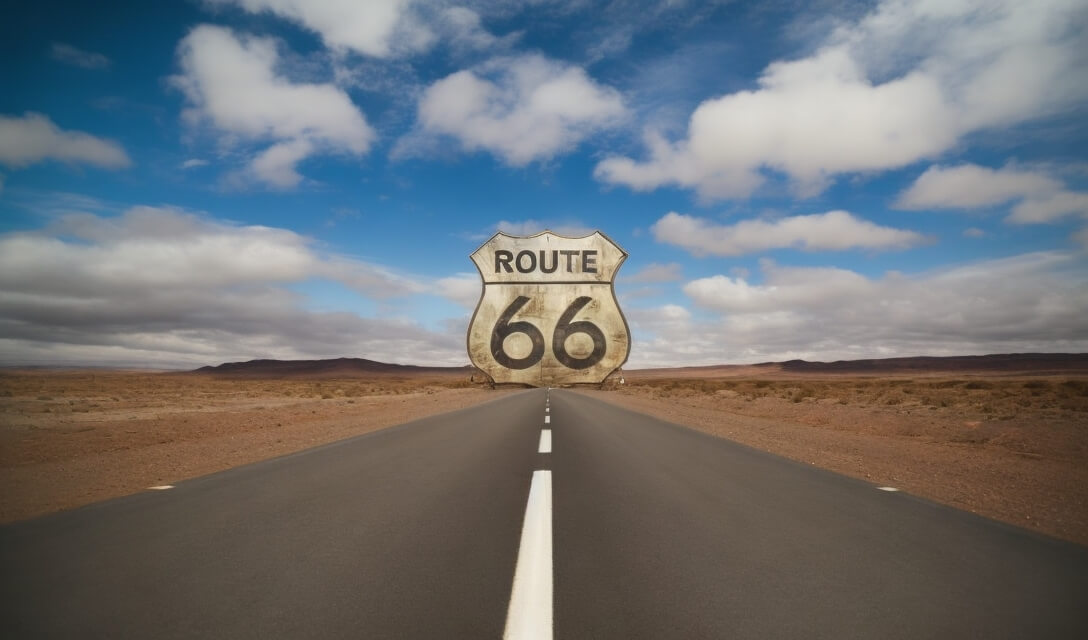
There’s a stretch of road that winds its way through the heartland of America. A path steeped in lore, draped in history, and echoing the hum of millions of tires. Its name is Route 66, but to many, it is much more than a mere roadway. From its start in Chicago, Illinois, to the salty air of Santa Monica, California at its end, Route 66 holds an irreplaceable position in the American collective consciousness.
You may have heard whispers about Route 66, the pulsating artery of America, the road that has connected countless individuals to new horizons and opportunities. You may wonder, why is Route 66 so famous? What about this patchwork ribbon of asphalt makes it resonate with so many people, not just in the United States, but worldwide?
Route 66 is a symbol, a tangible representation of freedom and the open road. The path itself has been the subject of countless songs, stories, and on-screen portrayals, each adding to its mystique. Despite this cultural reverence, some might be inclined to ask: does Route 66 still exist?
While it’s true that Route 66 was officially decommissioned as a U.S. Highway in 1985, its spirit refuses to fade. The end of Route 66 as an official highway did not spell its demise. Instead, it marked a new chapter in the road’s rich history. Today, the Route 66 we know exists as an amalgamation of local, state, and national highways, back roads, and historic loops. It remains open for all, inviting them on a journey of discovery and adventure.
It’s hard to fathom that this iconic path, born in 1926, stretches over 2,448 miles from the Great Lake to the Pacific Coast, touching eight states along the way. What’s even harder to imagine is the countless stories it holds in its clutches, each mile soaked with memories and imprinted with the spirit of times gone by. Among these spirits are those that offer a unique, otherworldly facet to the journey, embodying the many legends, tales, and myths of the famed highway.
This article aims to unearth these hidden treasures, revealing the true essence of Route 66. We’ll delve into its rich history, understand its cultural significance, and meet the fabled spirits that inhabit this legendary route. For it is these narratives, these fragments of an American dream, that make Route 66 an emblem of the human spirit. So, buckle up and get ready to join us on a journey where every turn holds a new story, every mile, a new revelation.
Historical Context and Significance

Route 66 has always been more than just a road. It was a lifeblood for countless communities and a beacon of hope for those seeking a better life during the Dust Bowl and the Great Depression. Named in 1926 and fully paved by the 1930s, Route 66 provided an escape for many from the barren, dust-choked farms of the Midwest to the promising fields of California.
Cyrus Avery, known as the Father of Route 66, once referred to it as “The Main Street of America”. Avery’s words were prophetic, as the route did become a main artery feeding the growth and development of the country. It connected the rural and urban, the past and the future, forming a bridge for cultural, economic, and social exchange.
However, with progress came change. When the Interstate Highway System began to take shape in the 1950s, Route 66’s importance began to wane. Highways were faster, straighter, and better suited for the booming post-war automotive culture. Many segments of Route 66 were bypassed, and by 1985, it was officially decommissioned. Yet, its significance was far from erased. Route 66’s closure sparked a renewed interest in preserving its rich history and unique culture.
Route 66’s historical village paints a vivid picture of its past glory. One such town is Seligman in Arizona, a town so untouched by time that it seems to exist in a bubble of the past. Seligman’s charm lies in its perseverance and its refusal to let the spirit of Route 66 fade away.
Another significant symbol is the historic Route 66 begin sign in Chicago. It’s a stark reminder of the route’s origins and the dreams it embodied. This is where countless journeys began, where hopes were kindled, and the open road beckoned the brave. The sign stands there still, a silent sentinel inviting new generations to embark on their own Route 66 journey.
Despite its official closure, Route 66 continues to live on, not just as a road, but as an essential piece of American history. From serving as the backdrop for John Steinbeck’s “The Grapes of Wrath” to becoming a symbol of freedom and a testament to America’s love affair with the open road, Route 66 has woven itself into the fabric of American identity.
The Legends of Route 66 Spirits
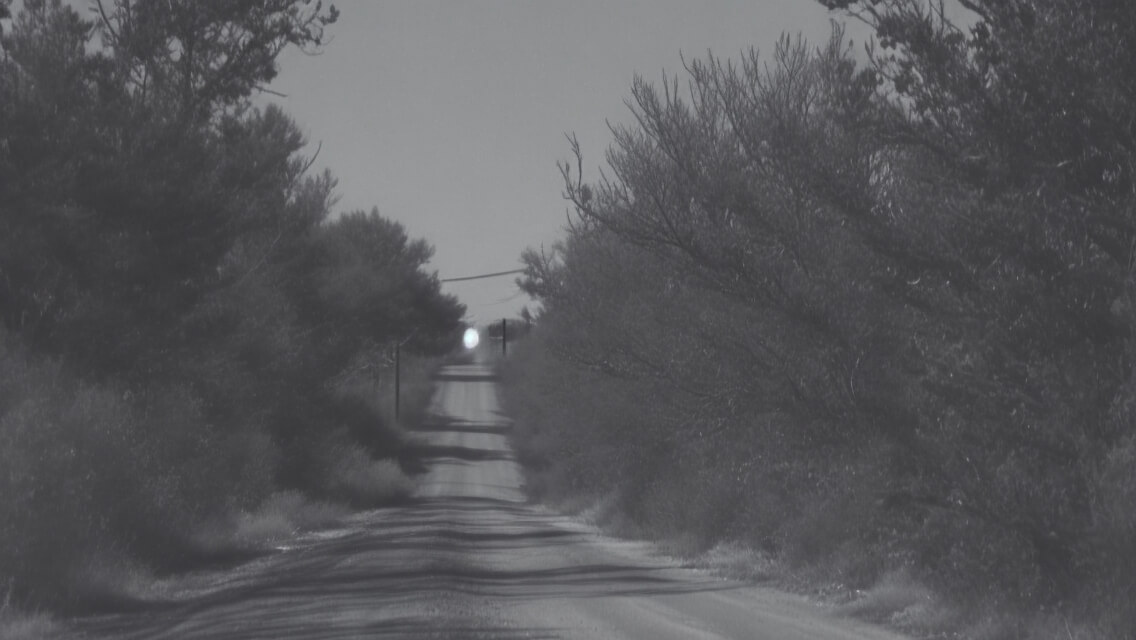
Venturing down the winding expanse of Route 66 is like opening a book filled with tales of the inexplicable and eerie. Legends of spirits and ghosts are an inseparable part of the Route 66 lore, lending an air of mystery and intrigue to its 2,448 miles. This part of the Route 66 story isn’t commonly told, yet it’s as riveting as any, filled with whispered accounts of spectral encounters and ghostly sightings.
In the state of Oklahoma, a cryptic narrative has been spun around The Avon Motel. Known to locals and travelers alike, it’s a place where unseen hands supposedly turn doorknobs, and ethereal shapes have been reported flitting across the property. The laughter of unseen children has been heard echoing down its long-abandoned corridors, suggesting that these unseen entities are not merely bound to Route 66, but woven into its very essence.
Another spectral tale revolves around the ghostly hitchhiker of La Bajada Hill in New Mexico. For decades, weary travelers have reported encounters with a ghostly figure. It appears out of the darkness, thumb outstretched for a ride, but vanishes before anyone can stop. Some say it’s the spirit of a long-ago traveler, eternally journeying along Route 66.
Among these tales, there are also reports of ghostly apparitions and phantom cars along the road near El Reno, Oklahoma. Some report a blue Chevy, circa 1950s, appearing out of nowhere only to disappear again into the thin air. Others speak of ghostly figures wandering aimlessly in the vast Arizona desert adjacent to Route 66, appearing in the headlights before fading into the night.
Even famous figures have their stories on Route 66. Elvis Presley, the King of Rock and Roll himself, reportedly frequented the Best Western in Albuquerque, New Mexico, while traveling Route 66. Today, some guests have reported hearing the strumming of a guitar and faint singing in Elvis’ favorite room, fueling speculations of the King’s eternal ties to Route 66.
Traveling Route 66 Today
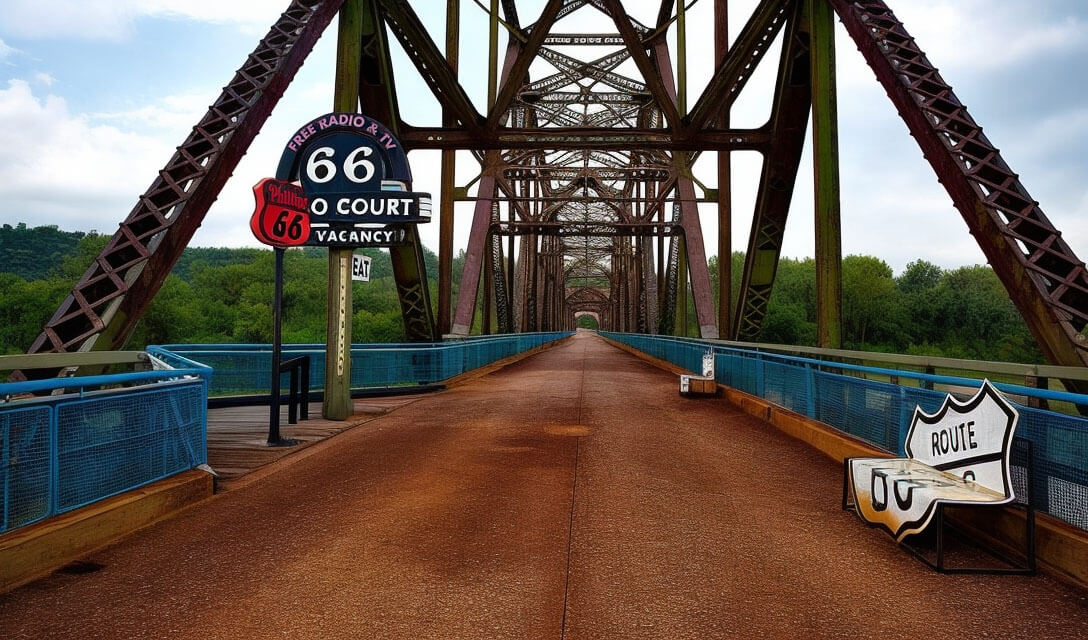
Though times have changed and faster interstates have overshadowed Route 66, its attraction remains undiminished. Exploring Route 66 today is like stepping into a living museum, where every mile brings new sights, experiences, and stories to uncover. For those seeking to embark on this journey, a popular tool is the EZ66 guide. It offers detailed directions, highlights key points of interest, and even provides advice on places to eat and stay.
One might wonder, how long does it take to drive Route 66? It depends on how deep you want to delve into its treasures. If you’re speeding through, you might finish in a few days. However, to truly appreciate Route 66, it’s recommended to spend at least two weeks, allowing time to immerse in the different towns and landmarks along the way.
Route 66 Raceway, located in Joliet, Illinois, is one such stop. A staple for adrenaline junkies, the raceway hosts a variety of events from drag racing to music festivals, offering a modern taste of the Route 66 spirit.
An unmissable landmark is the historic Chain of Rocks Bridge spanning the Mississippi River, once the path of Route 66. Today, it stands as a pedestrian bridge, inviting travelers to soak in panoramic views and understand the significance of this route that bridged the eastern and western United States.
Even after so many years, the spirit of Route 66 is alive and well. It continues to be an avenue for adventure, inviting travelers to step into the past while exploring the present. To quote the Smithsonian’s National Museum, which houses an actual piece of Route 66 pavement: “Route 66 has become a powerful symbol of America’s social, political and economic mobility and freedom.”
The Route 66 in Popular Culture
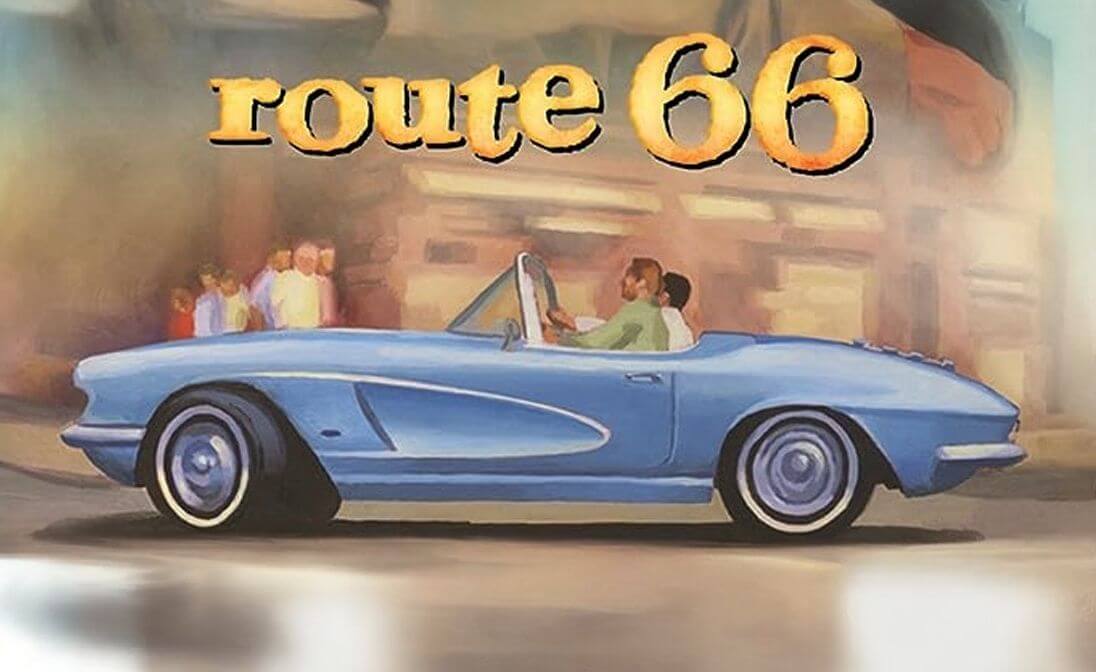
The influence of Route 66 has permeated popular culture over the years. It has inspired musicians, filmmakers, and writers, creating a unique cultural mosaic. The “Route 66 song” written by Bobby Troup, has been covered by countless artists from Nat King Cole to The Rolling Stones, each rendition offering a different taste of the Route 66 allure.
In the realm of animation, the charming town of Radiator Springs in Pixar’s “Cars” is a clear nod to the many quaint towns dotted along Route 66. The film showcases numerous references to actual Route 66 locations and landmarks, presenting an animated tribute to this iconic route.
Television too couldn’t resist the allure of Route 66. The 1960s TV series “Route 66” followed two young men exploring America in their Corvette convertible, meeting different people and encountering various adventures along the way. The show captured the essence of Route 66 as a path of discovery and exploration, further embedding the route in American pop culture.
While these representations have played a significant role in popularizing Route 66, they have also contributed to preserving its legacy. Each song, film, or TV show helps keep the spirit of Route 66 alive, cementing its status as a timeless emblem of America’s cultural heritage.
Notable Locations along Route 66
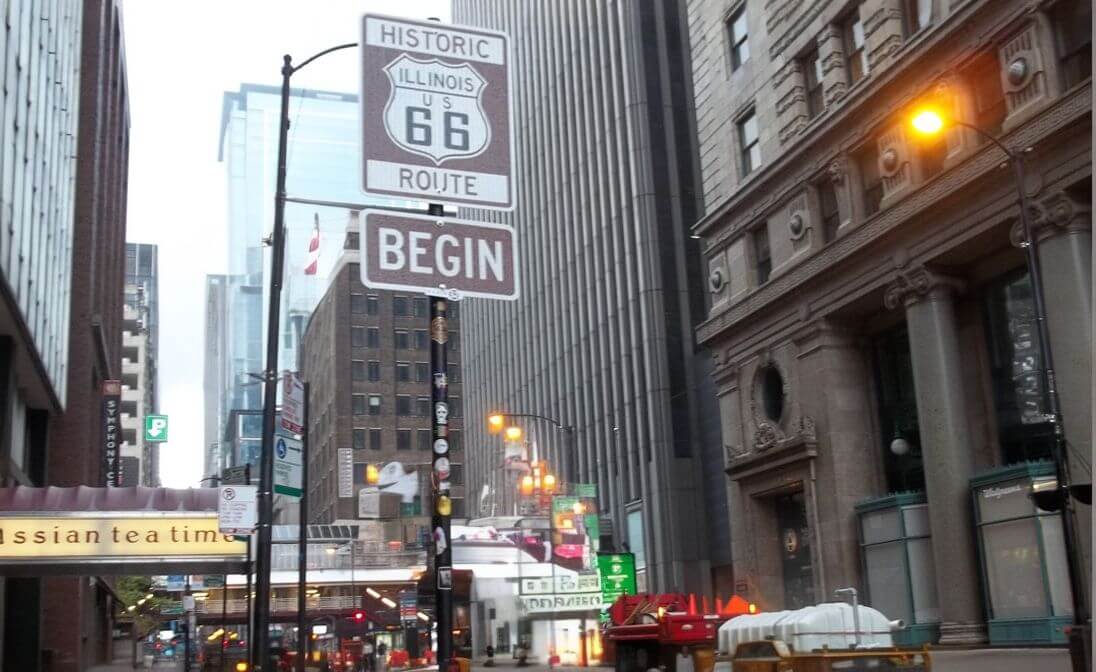
As the highway meanders across eight different states, Route 66 boasts a multitude of diverse and iconic locations that form the physical and spiritual backbone of this legendary route. From Illinois to California, the states of Route 66 each contribute unique elements that enrich the Route 66 tapestry.
Starting from Chicago, Illinois, the Route 66 journey unfolds. The iconic Route 66 Begin Sign stands proudly downtown, marking the start of the historic path. The city also houses the oldest hotel on Route 66, the Eagle Hotel in Wilmington, a must-visit spot that gives visitors a taste of the route’s early days.
Further along the route in St. Louis, Missouri, the Gateway Arch marks an impressive sight, while the Meramec Caverns beckon with underground wonders. From the remnants of the thriving mining town of Galena, Kansas, to the bustling cityscape of Tulsa, Oklahoma, the diversity of experiences along Route 66 is truly staggering.
The state of Texas brings its own charm to Route 66, with locations like the towering Cadillac Ranch near Amarillo, where graffiti-covered cars stand nose-down in the desert. Further west in New Mexico, the city of Albuquerque offers its rich cultural heritage to the Route 66 story.
In Arizona, Route 66 takes travelers on a scenic drive through the Petrified Forest National Park, where geological wonders await. The state is also home to the quirky town of Oatman, where wild burros roam the streets, adding to the unique Route 66 charm.
Last but not least, the journey culminates in the sunny state of California, where the Santa Monica Pier marks the end of Route 66. Here, travelers can celebrate the completion of their journey, looking out over the vast Pacific Ocean.
One remarkable location along the way is the ghost town of Amboy in California, home to the famous Roy’s Motel and Cafe, a sight known for the towering sign that has become synonymous with Route 66. Nearby, the Amboy Crater, an extinct volcano that once loomed over Route 66, stands as a testament to the natural history that this route has traversed.
Conclusion
From tales of Route 66 spirits to the vibrant pulse of Route 66 today, the legacy of this historic highway is rich and varied. Traversing eight states and countless towns, Route 66 has been more than just a road. It has been, and continues to be, a vital thread in the fabric of American history, culture, and imagination.
For those who ask, where does Route 66 end, the answer isn’t merely a geographic location, but a concept. The end of Route 66 isn’t just the Santa Monica Pier in California, it’s the culmination of an adventure, a journey through time, history, and countless stories that have made this highway a living testament to American spirit and freedom.
From the resonating chords of the “Route 66 song” to the quiet specter of Route 66 spirits, every element adds depth to the tale of America’s most iconic highway. We’ve traveled through the allure of the Route 66 Raceway, stepped into the animated charm of Radiator Springs, and have been guests in the countless towns that dot this remarkable route.
So, what makes Route 66 so famous? Perhaps it’s the lure of the open road, the freedom it represents, or maybe it’s the countless stories, both human and supernatural, that have unfolded along its expanse. Or perhaps, it’s the unbroken connection to a simpler time, preserved by the worn road signs, vintage motels, and classic diners. But most importantly, Route 66 embodies a sense of discovery and adventure that speaks to the heart of the American spirit, beckoning travelers with the promise of the open road and all the treasures it holds.
So, as we reach the end of our journey, we find that the true spirit of Route 66 isn’t merely about the miles it spans, the states it crosses, or even the locations along its path. It’s about the stories it tells, the legends it inspires, and the millions of hearts it continues to touch. That is the true magic of Route 66, and long may it continue.


